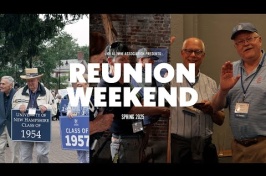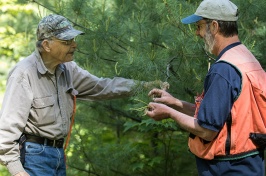Whippoorwill
A New Hampshire teenager tries to save an abused dog

Sixteen-year-old Clair Taylor lives in a house that has a junk-filled bathtub on its weedy lawn. She hates that people might think that she and her widowed biker father are “Whippoorwills,” the nickname in her part of northern New Hampshire for the sort of pack rats who fill their backyards with broken-down cars or worse.
The sensitive narrator of Whippoorwill (Houghton Mifflin Harcourt), by Joseph Monninger ’84G, Clair is smart enough to know that she faces a more serious problem than that bathtub in her yard. A neighbor is abusing an old black Labrador retriever named Wally, and the dog may die if she doesn’t intervene.
As she tries to save Wally, Clair finds inspiration in a bestselling dog-training manual by a priest who “found in a dog’s love the merciful acceptance he hoped to receive from God” and from other people. She also gets help from her offbeat father and from
an 18-year-old boy who may be falling in love with her. Will all of it be enough to protect Clair — and Wally — from the wrath of the dog’s potentially violent owner?
The stakes rise swiftly, and amid the escalating action, Monninger develops large themes that forge links between human and canine nature, and between two- and four-footed pack animals. Perhaps the most important is that dogs, like people, need both love and discipline. “You get what you put into a person, the same way you get what you put into a dog,” Clair observes. But loving an animal raises difficult questions of its own. And as every owner of an old pet knows, none is more painful than the one that Clair ultimately faces in Whippoorwill: When should you hold onto a pet, and when should you let it go?
The Life of Images
A Pulitzer Prize–winner writes about topics from art to sausage

On the eve of the year 2000, the tabloids predicted that a monument to Elvis would appear on Mars, the poet Charles Simic recalls in The Life of Images (Ecco/HarperCollins 2015). What might the millennium hold for poets with less celestial interests, such as how to pay the rent?
“You do not have to be a Nostradamus to predict that the poets will be doing exactly what they’ve been doing for the last three thousand years: howling and kicking about how nobody ever appreciates them,” Simic writes with the wry humor that is the hallmark of this collection of 41 of his best essays, written for publications from Food and Wine to the New York Review of Books.
But Simic is too wise to complain in this book about any slights of his own work, which has earned him Pulitzer Prize, a MacArthur “genius” grant, and a term as the U.S. Poet Laureate. His essays deal instead with his wide-ranging enthusiasms — art, music, sausage, philosophy, Buster Keaton films and the books of E.M. Cioran and Witold Gombrowicz — and often suggest links between such interests and poetry. His themes include the primacy of individual thought and action and his skepticism of ideologies that range from literary movements to nationalism in his native Belgrade. “Has any genuine artist ever thought of himself or herself exclusively as a part of a movement?” he asks.
Simic doesn’t write in The Life of Images about UNH, where he began teaching in1973 and is a professor emeritus of English. Still, his book hints at how he has dealt with students and faculty. When Simic says that, as a young man, “I always held unpopular opinions and was not afraid to voice them,” you can easily imagine how lively his classes — and some English department meetings — must have been.
Of Note

Welcome to Frost Heaves, New Hampshire
by Fred Marple, Islandport Press, May 2015
In the grand tradition of Mark Twain and Lake Wobegon, humorist Ken Sheldon ’76 offers up observations on the fictional town of Frost Heaves, “the most underappreciated town in New Hampshire,” through the eyes of fictional persona Fred Marple. As Marple, Sheldon has been featured on New Hampshire Chronicle and radio programs as well as in Yankee Magazine and New Hampshire Magazine.

Little Woman in Blue, A Novel of May Alcott
by Jeannine Atkins ‘80G, September 2015
A fictional account of the life of the “other” Alcott sister that explores the complex, often fraught relationship between artist May Alcott and
writer Louisa, author of the wildly popular novel Little Women.

Sexploitation: Helping Kids Develop Healthy Sexuality in a Porn-Driven World
by Cindy Pierce ’88, Biblio-motion, Inc., October 2015
Sex educator and college speaker Pierce draws from stories of young adults dealing with daily pressures that are exacerbated by sex in the media and provides parents and educators with the tools they need to help kids develop healthy sexual identities.
Originally published in UNH Magazine—Fall 2015 Issue
-
Written By:
Janice Harayda '70 | Communications and Public Affairs



















































